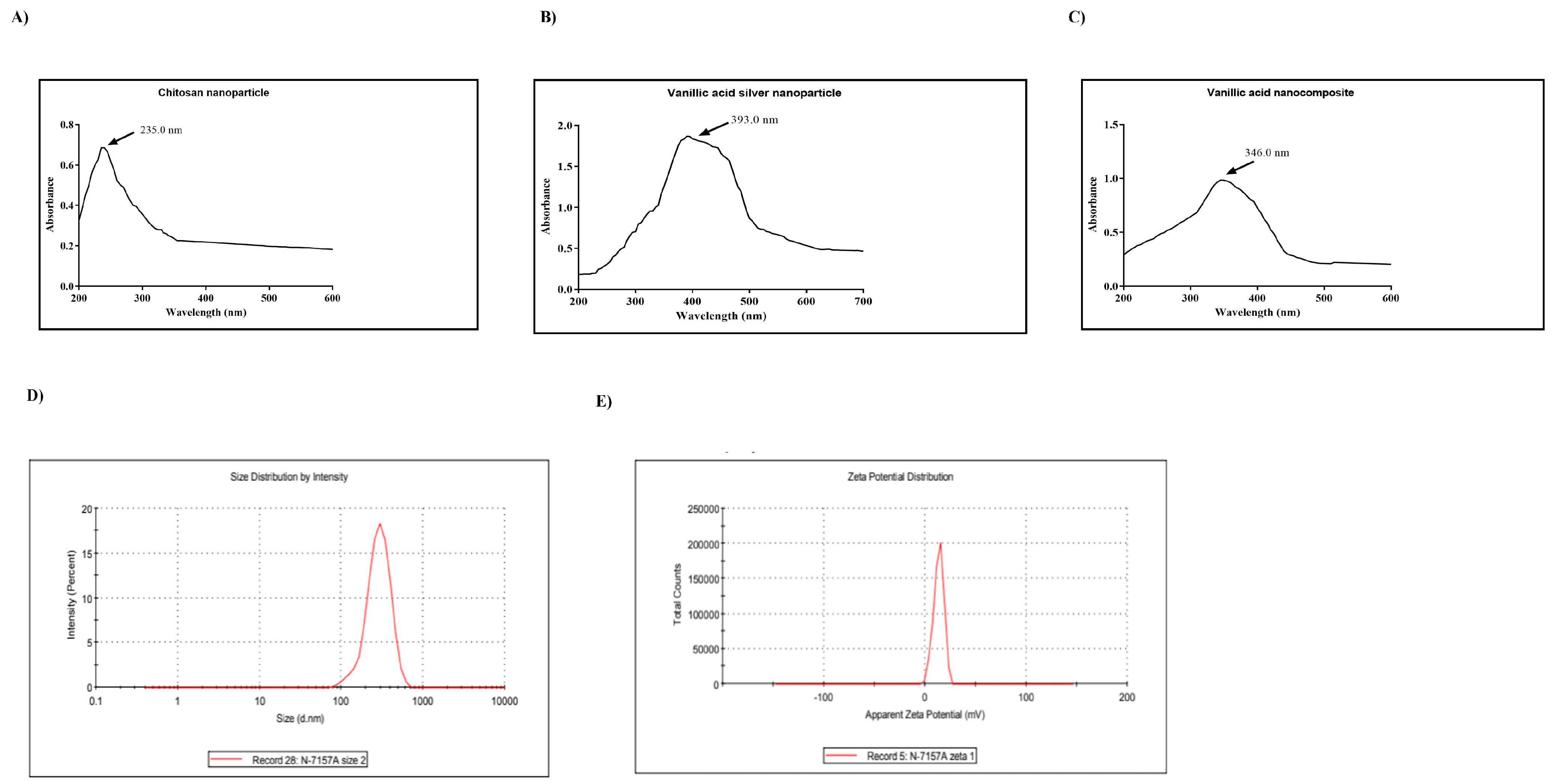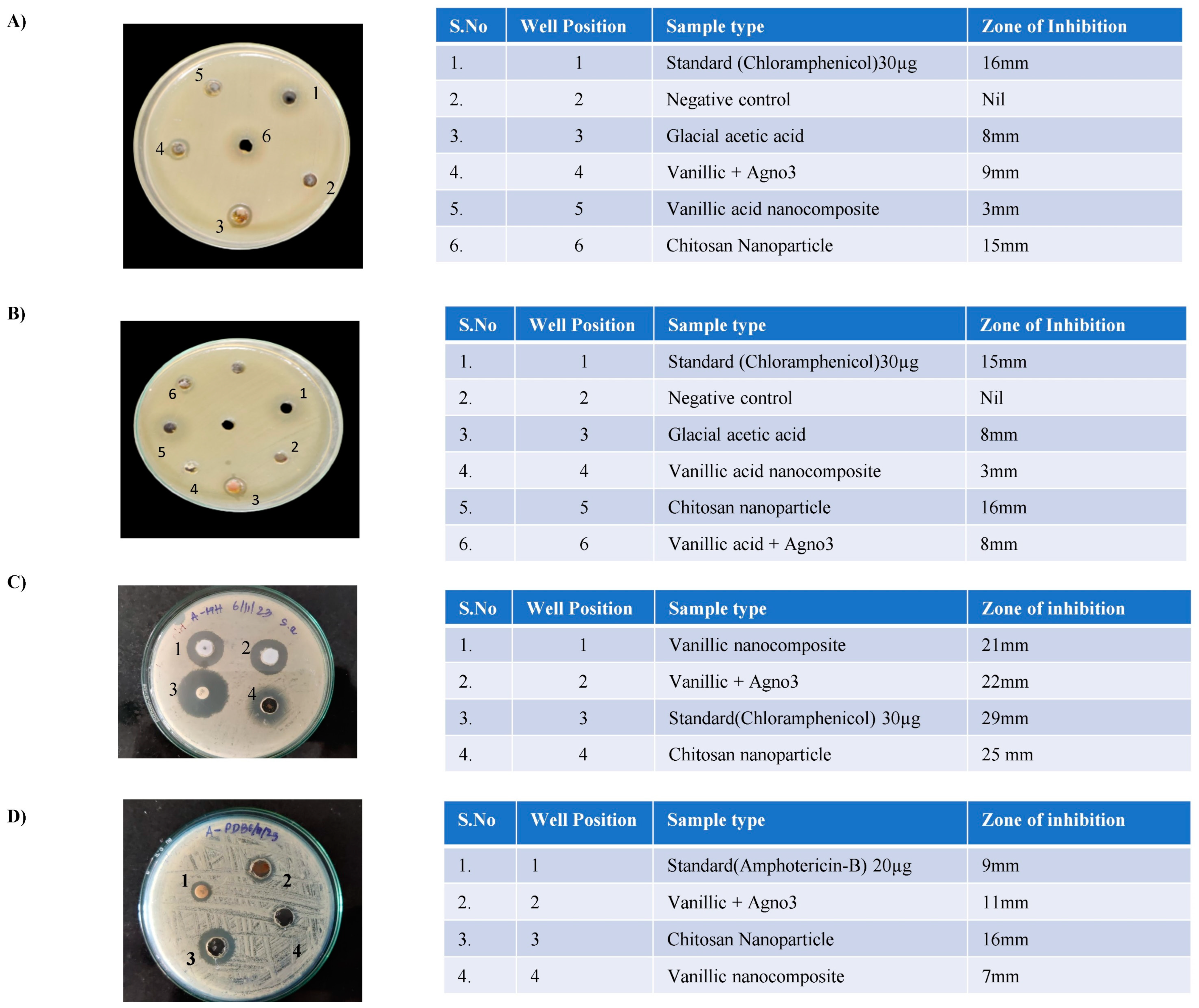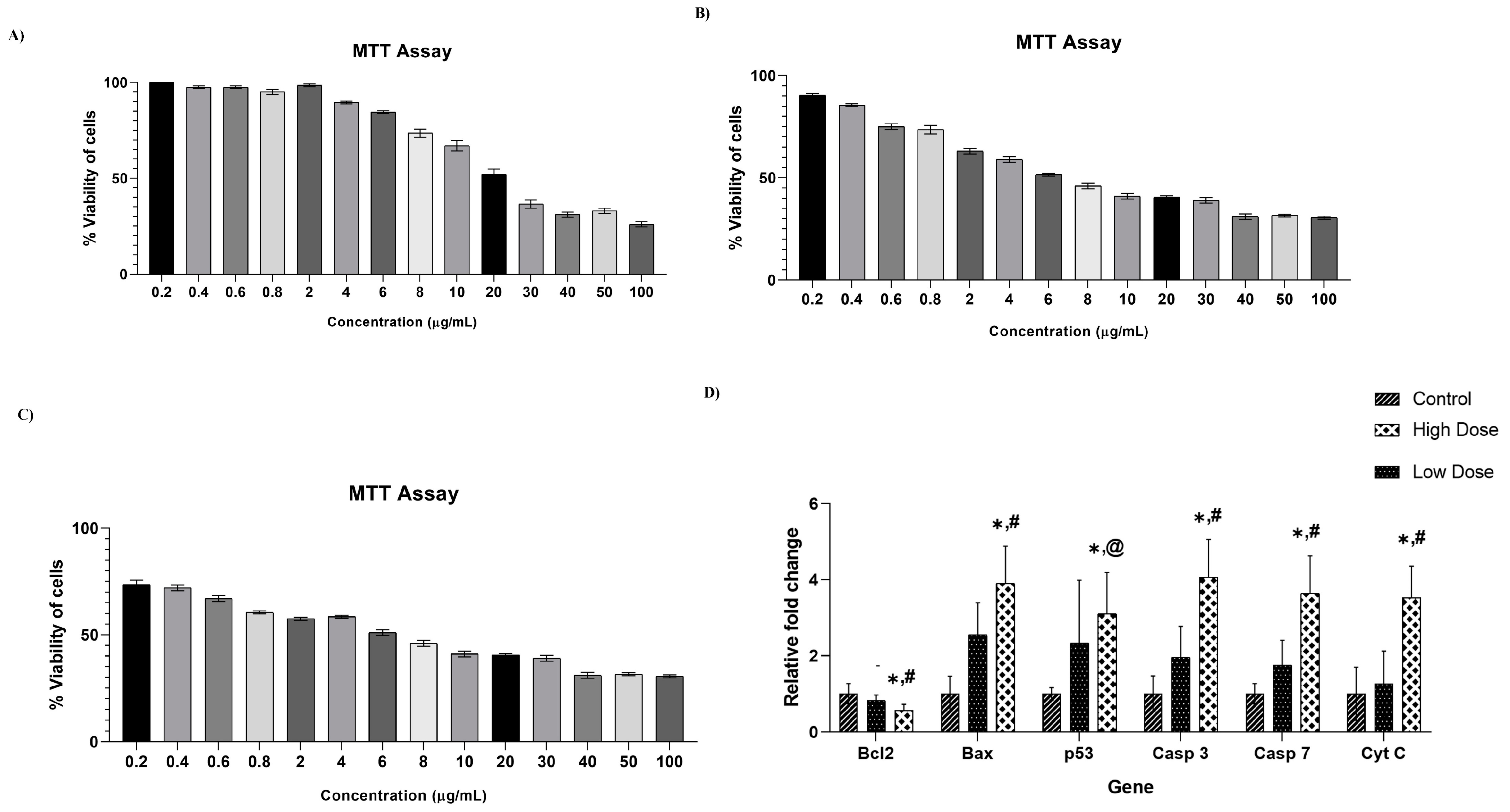Vanillic Acid Nanocomposite: Synthesis, Characterization Analysis, Antimicrobial, and Anticancer Potentials
Abstract
1. Introduction
2. Results
2.1. Characterization of Synthesized Vanillic Acid Nanocomposite
2.2. Antimicrobial Activities of Vanillic Acid Nanocomposite
2.3. Effect of Vanillic Acid Nanocomposite on Cell Viability
2.4. Effect of Vanillic Acid Nanocomposite on Apoptosis
3. Discussion
4. Materials and Methods
4.1. Chemicals
4.2. Synthesis of Vanillic Acid Nanocomposite
4.3. UV-Visible Spectrophotometry Analysis
4.4. FTIR Analysis
4.5. Zeta Size and Zeta Potential Analyses
4.6. FESEM
4.7. TGA-DSC
4.8. Antimicrobial Potential of Vanillic Acid Nanocomposite
4.9. Cell Lines and Conditions
4.10. MTT Assay
4.11. PCR and Gene Expression
4.12. Statistical Analysis
5. Conclusions
Author Contributions
Funding
Institutional Review Board Statement
Informed Consent Statement
Data Availability Statement
Conflicts of Interest
References
- Sung, H.; Ferlay, J.; Siegel, R.L.; Laversanne, M.; Soerjomataram, I.; Jemal, A.; Bray, F. Global Cancer Statistics 2020: GLOBOCAN Estimates of Incidence and Mortality Worldwide for 36 Cancers in 185 Countries. CA Cancer J. Clin. 2021, 71, 209–249. [Google Scholar] [CrossRef]
- Velli, S.K.; Sundaram, J.; Murugan, M.; Balaraman, G.; Thiruvengadam, D. Protective effect of vanillic acid against benzo(a)pyrene induced lung cancer in Swiss albino mice. J. Biochem. Mol. Toxicol. 2019, 33, e22382. [Google Scholar] [CrossRef]
- Rivera, M.P.; Mehta, A.C.; Wahidi, M.M. Establishing the diagnosis of lung cancer: Diagnosis and management of lung cancer: American College of Chest Physicians evidence-based clinical practice guidelines. Chest 2013, 143 (Suppl. 5), e142S–e165S. [Google Scholar] [CrossRef] [PubMed]
- Kozower, B.D.; Larner, J.M.; Detterbeck, F.C.; Jones, D.R. Special Treatment Issues in Non-Small Cell Lung Cancer: Diagnosis and Management of Lung Cancer: American College of Chest Physicians Evidence-Based Clinical Practice Guidelines. Chest 2013, 143 (Suppl. 5), e369S–e399S. [Google Scholar] [CrossRef] [PubMed]
- Horikoshi, S.; Serpone, N. (Eds.) Microwaves in Nanoparticle Synthesis: Fundamentals and Applications; John Wiley & Sons: Hoboken, NJ, USA, 2013. [Google Scholar]
- Ahmed, S.F.; Mofijur, M.; Rafa, N.; Chowdhury, A.T.; Chowdhury, S.; Nahrin, M.; Islam, A.B.M.S.; Ong, H.C. Green approaches in synthesising nanomaterials for environmental nanobioremediation: Technological advancements, applications, benefits and challenges. Environ. Res. 2022, 204, 111967. [Google Scholar] [CrossRef]
- Zuhrotun, A.; Oktaviani, D.J.; Hasanah, A.N. Biosynthesis of Gold and Silver Nanoparticles Using Phytochemical Compounds. Molecules 2023, 28, 3240. [Google Scholar] [CrossRef] [PubMed]
- Prince, S.M.; Rajakumar, S.; Dhanasekar, K. Protective effects of vanillic acid on electrocardiogram, lipid peroxidation, antioxidants, proinflammatory markers and histopathology in isoproterenol induced cardiotoxic rats. Eur. J. Pharmacol. 2011, 668, 233–240. [Google Scholar] [CrossRef] [PubMed]
- Kanna, V.S.; Jagan, S.; Sharmila, S.; Palanisamy, K.; Nirmala, S.; Devaki, T. Vanillic acid attenuates cell proliferation, xenobiotic enzyme activity, and the status of pulmonary mitochondrial enzymes in lung carcinoma. J. Food Biochem. 2022, 46, e14366. [Google Scholar] [CrossRef]
- Alamri, E.S.; El Rabey, H.A.; Alzahrani, O.R.; Almutairi, F.M.; Attia, E.S.; Bayomy, H.M.; Albalwi, R.A.; Rezk, S.M. Enhancement of the Protective Activity of Vanillic Acid against Tetrachloro-Carbon (CCl4) Hepatotoxicity in Male Rats by the Synthesis of Silver Nanoparticles (AgNPs). Molecules 2022, 27, 8308. [Google Scholar] [CrossRef]
- Huang, Y.; Chen, J.; Lin, J.; Lin, J.; Chen, X. Preparation of Vanillic Acid-Loaded Core-Shell Gold Nanospheres/Mesoporous Silica Nanoparticles for the Treatment of Orthopedic Infection. ACS Omega 2021, 6, 2899–2905. [Google Scholar] [CrossRef]
- Lim, S.P.; Pandikumar, A.; Huang, N.M.; Lim, H.N. Enhanced photovoltaic performance of silver@ titania plasmonic photoanode in dye-sensitized solar cells. RSC Adv. 2014, 4, 38111–38118. [Google Scholar] [CrossRef]
- Liu, T.; Liu, B.; Yang, L.; Ma, X.; Li, H.; Yin, S.; Sato, T.; Sekino, T.; Wang, Y. RGO/Ag2S/TiO2 ternary heterojunctions with highly enhanced UV-NIR photocatalytic activity and stability. Appl. Catal. B Environ. 2017, 204, 593–601. [Google Scholar] [CrossRef]
- Keawchaoon, L.; Yoksan, R. Preparation, characterization and in vitro release study of carvacrol-loaded chitosan nanoparticles. Colloids Surf. B Biointerfaces 2011, 84, 163–171. [Google Scholar] [CrossRef]
- Hosseini, S.F.; Zandi, M.; Rezaei, M.; Farahmandghavi, F. Two-step method for encapsulation of oregano essential oil in chitosan nanoparticles: Preparation, characterization and in vitro release study. Carbohydr. Polym. 2013, 95, 50–56. [Google Scholar] [CrossRef]
- Stalin, T.; Rajendiran, N. A study on the spectroscopy and photophysics of 4-hydroxy-3-methoxybenzoic acid in different solvents, pH and β-cyclodextrin. J. Mol. Struct. 2006, 794, 35–45. [Google Scholar] [CrossRef]
- Roy, S.; Zhai, L.; Kim, H.C.; Pham, D.H.; Alrobei, H.; Kim, J. Tannic-Acid-Cross-Linked and TiO2-Nanoparticle-Reinforced Chitosan-Based Nanocomposite Film. Polymers 2021, 13, 228. [Google Scholar] [CrossRef]
- Ferrero, F.; Periolatto, M. Antimicrobial finish of textiles by chitosan UV-curing. J. Nanosci. Nanotechnol. 2012, 12, 4803–4810. [Google Scholar] [CrossRef] [PubMed]
- Firoozabadi, F.D.; Saadatabadi, A.R.; Asefnejad, A. In Vitro Studies and Evaluation of Antibacterial Properties of Biodegradable Bone Joints Based on PLA/PCL/HA. J. Clin. Res. Paramed. Sci. 2022, 11, e124080. [Google Scholar] [CrossRef]
- Siddiqui, N.; Bhardwaj, A.; Shaikh, A.; Jain, A.; Verma, S.K. Effect of silver loading on optical and antibacterial behavior of Poly (methyl methacrylate). Orient. J. Chem. 2014, 30, 1777–1783. [Google Scholar] [CrossRef][Green Version]
- Stegarescu, A.; Lung, I.; Ciorîță, A.; Kacso, I.; Opriș, O.; Soran, M.L.; Soran, A. The Antibacterial Properties of Nanocomposites Based on Carbon Nanotubes and Metal Oxides Functionalized with Azithromycin and Ciprofloxacin. Nanomaterials 2022, 12, 4115. [Google Scholar] [CrossRef]
- Ahmadi, R.; Fatahi, R.F.; Sangpour, P.; Bagheri, M.; Rahimi, T. Evaluation of antibacterial behavior of in situ grown CuO-GO nanocomposites. Mater. Today Commun. 2021, 28, 102642. [Google Scholar] [CrossRef]
- Shang, B.; Xu, M.; Zhi, Z.; Xi, Y.; Wang, Y.; Peng, B.; Li, P.; Deng, Z. Synthesis of sandwich-structured silver@polydopamine@silver shells with enhanced antibacterial activities. J. Colloid Interface Sci. 2020, 558, 47–54. [Google Scholar] [CrossRef] [PubMed]
- Mao, C.; Xiang, Y.; Liu, X.; Zheng, Y.; Yeung, K.W.K.; Cui, Z.; Yang, X.; Li, Z.; Liang, Y.; Zhu, S.; et al. Local Photothermal/Photodynamic Synergistic Therapy by Disrupting Bacterial Membrane To Accelerate Reactive Oxygen Species Permeation and Protein Leakage. ACS Appl. Mater. Interfaces 2019, 11, 17902–17914. [Google Scholar] [CrossRef]
- Ayub, M.; Othman, M.H.D.; Khan, I.U.; Yusop, M.Z.M.; Kurniawan, T.A. Graphene-based nanomaterials as antimicrobial surface coatings: A parallel approach to restrain the expansion of COVID-19. Surf. Interfaces 2021, 27, 101460. [Google Scholar] [CrossRef] [PubMed]
- Du, T.; Chen, S.; Zhang, J.; Li, T.; Li, P.; Liu, J.; Du, X.; Wang, S. Antibacterial Activity of Manganese Dioxide Nanosheets by ROS-Mediated Pathways and Destroying Membrane Integrity. Nanomaterials 2020, 10, 1545. [Google Scholar] [CrossRef] [PubMed]
- Duan, S.; Wu, R.; Xiong, Y.H.; Ren, H.M.; Lei, C.; Zhao, Y.Q.; Zhang, X.Y.; Xu, F.J. Multifunctional antimicrobial materials: From rational design to biomedical applications. Prog. Mater. Sci. 2022, 125, 100887. [Google Scholar] [CrossRef]
- Akhavan, O.; Ghaderi, E.; Esfandiar, A. Wrapping bacteria by graphene nanosheets for isolation from environment, reactivation by sonication, and inactivation by near-infrared irradiation. J. Phys. Chem. B 2011, 115, 6279–6288. [Google Scholar] [CrossRef] [PubMed]
- Scherzad, A.; Meyer, T.; Kleinsasser, N.; Hackenberg, S. Molecular Mechanisms of Zinc Oxide Nanoparticle-Induced Genotoxicity Short Running Title: Genotoxicity of ZnO NPs. Materials 2017, 10, 1427. [Google Scholar] [CrossRef]
- Shen, C.; James, S.A.; de Jonge, M.D.; Turney, T.W.; Wright, P.F.; Feltis, B.N. Relating cytotoxicity, zinc ions, and reactive oxygen in ZnO nanoparticle-exposed human immune cells. Toxicol. Sci. 2013, 136, 120–130. [Google Scholar] [CrossRef]
- Gao, C.; Wang, A.Y. Significance of increased apoptosis and Bax expression in human small intestinal adenocarcinoma. J. Histochem. Cytochem. 2009, 57, 1139–1148. [Google Scholar] [CrossRef]
- Dakubo, J.C.; Naaeder, S.B.; Tettey, Y.; Gyasi, R.K. Colorectal carcinoma: An update of current trends in Accra. West Afr. J. Med. 2010, 29, 178–183. [Google Scholar] [CrossRef] [PubMed]
- Kheiltash, F.; Parivar, K.; Hayati Roodbari, N.; Sadeghi, B.; Badiei, A. Effects of 8-hydroxyquinoline-coated graphene oxide on cell death and apoptosis in MCF-7 and MCF-10 breast cell lines. Iran J. Basic Med. Sci. 2020, 23, 871–878. [Google Scholar] [CrossRef] [PubMed]





| Gene | Forward | Reverse |
|---|---|---|
| Caspase-3 | 5′TTTTTCAGAGGGGATCGTTG3′ | 5′CGGCCTCCACTGGTATTTTA3′ |
| Caspase-7 | 5′AGTGACAGGTATGGGCGTTC3′ | 5′CGGCATTTGTATGGTCCTCT3′ |
| B-Actin | 5′CTCTTCCAGCCTTCCTTCCT3′ | 5′AGCACTGTGTTGGCGTACAG3′ |
| p53 | 5′TTCCTGAAAACAACGTTCTGTC3′ | 5′AACCATTGTTCAATATCGTCCG3′ |
| BAX | 5′CGAACTGGACAGTAACATGGAG3′ | 5′CAGTTTGCTGGCAAAGTAGAAA3′ |
| Bcl2 | 5′GACTTCGCCGAGATGTCCAG3′ | 5′GAACTCAAAGAAGGCCACAATC3′ |
| Cyt-C | 5′CGTTGTGCCAGCGACTAAAAA3′ | 5′GATTTGGCCCAGTCTTGTGC3′ |
Disclaimer/Publisher’s Note: The statements, opinions and data contained in all publications are solely those of the individual author(s) and contributor(s) and not of MDPI and/or the editor(s). MDPI and/or the editor(s) disclaim responsibility for any injury to people or property resulting from any ideas, methods, instructions or products referred to in the content. |
© 2024 by the authors. Licensee MDPI, Basel, Switzerland. This article is an open access article distributed under the terms and conditions of the Creative Commons Attribution (CC BY) license (https://creativecommons.org/licenses/by/4.0/).
Share and Cite
Venkidasamy, B.; Subramanian, U.; Almoallim, H.S.; Alharbi, S.A.; Lakshmikumar, R.R.C.; Thiruvengadam, M. Vanillic Acid Nanocomposite: Synthesis, Characterization Analysis, Antimicrobial, and Anticancer Potentials. Molecules 2024, 29, 3098. https://doi.org/10.3390/molecules29133098
Venkidasamy B, Subramanian U, Almoallim HS, Alharbi SA, Lakshmikumar RRC, Thiruvengadam M. Vanillic Acid Nanocomposite: Synthesis, Characterization Analysis, Antimicrobial, and Anticancer Potentials. Molecules. 2024; 29(13):3098. https://doi.org/10.3390/molecules29133098
Chicago/Turabian StyleVenkidasamy, Baskar, Umadevi Subramanian, Hesham S. Almoallim, Sulaiman Ali Alharbi, Rahul Raj Chennam Lakshmikumar, and Muthu Thiruvengadam. 2024. "Vanillic Acid Nanocomposite: Synthesis, Characterization Analysis, Antimicrobial, and Anticancer Potentials" Molecules 29, no. 13: 3098. https://doi.org/10.3390/molecules29133098
APA StyleVenkidasamy, B., Subramanian, U., Almoallim, H. S., Alharbi, S. A., Lakshmikumar, R. R. C., & Thiruvengadam, M. (2024). Vanillic Acid Nanocomposite: Synthesis, Characterization Analysis, Antimicrobial, and Anticancer Potentials. Molecules, 29(13), 3098. https://doi.org/10.3390/molecules29133098









